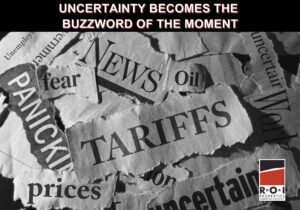Phoenix real estate appraiser Jay Josephs, founder and owner of Josephs Appraisal Group and chief appraiser for Apex, a national appraisal management company, has been in the business for 30 years. As a result, he has seen some crazy markets—but he describes the past six months as about as challenging as he has ever experienced. R.O.I. Properties recently interviewed him for an overview of the markets, including recommendations for sellers and their real estate agents.
Q: What have the past few months looked like from an appraiser’s perspective?
A: In March and April, it was almost like flying blind—in the middle of a pandemic, something I’d never imagined I would experience. I’m seeing people lose their jobs. I’m seeing stock portfolio values diminish. I’m seeing people uncomfortable with their employment status, and business owners concerned about their mid-range projections. All those things should significantly reduce the demand, but without having the historical frame of reference, it was hard to quantify property values. Once we rolled into May, things began to get clearer, and looking back now, I’m really surprised about what we went through. For months, people were hoping for a so-called V-shaped recovery. I didn’t really know what that meant until I looked at the numbers for March through July, but that’s exactly what it was.
Q: How did you adjust your approach to address the strange market behaviors?
A: As appraisers, everything we do depends on data and statistics. In the Arizona Regional MLS listings, from March through May, month-by-month closings dropped by 21% and the price per square foot dropped by 23%. I’ve never seen that before. Then May to June, closings went up 38% and the price per square foot went up 11%. The trend of significant appreciation has continued, with ARMLS average sales prices of $369,249 in June, $394,462 in July, $402,222 in August, and $412,424 in September. As an appraiser, it is so difficult to keep up with this level of appreciation. I would call it unprecedented.
You could make a really strong case that you shouldn’t really consider April and May sales, because they were such an aberration, so I do try to focus more on the past three months. If I have to use an April or May sale, part of my process with the underwriter is to explain what we were in the middle of. One of the reasons we’ve seen a high frequency of appraisals come in low is that they haven’t accounted for the nuances of what’s gone on in the market. In a gradually rising market, it’s easy to make time adjustments. For example, 0.5% a month gives you a 2.5% upward adjustment if a sale was five months ago. It’s a lot more complicated when prices are up 11% in one month, and down 9% the next.
Q: Now that the market has heated back up again, are there any trends that concern you?
A: A lack of supply has led to price increases, but you have to be careful in markets like this, because appreciation levels can become unsustainable very quickly. I don’t have a tool in my toolbox to account for 15% appreciation in two months. When somebody sells their house $50,000 higher than any other house in the neighborhood, all the neighbors start thinking, “Wow, let’s move.” If enough people do that, all of a sudden you don’t have a scarcity of supply.
Q: What specific advice do you have for sellers in the current Phoenix real estate market?
A: Homeowners should request that their real estate agent meet with the appraiser at the property, turns on the lights and opens doors—not just ask us to use the lockbox. As the seller, it’s more important than ever to be out of the house during the appraisal, since that’s more of a concern in the coronavirus era.
A second item is to recognize that appraisers are really busy right now, so ask your agent to put together a package with comps, upgrades, and features. Comps generally get less consideration if they’re provided after the appraisal—and once an underwriter has seen an appraiser’s opinion of value, it’s much more difficult to change.
If you are fortunate enough to have multiple offers, that can make a difference for the appraiser too. When your agent shows up to the inspection with a lockbox log with 16 showings in three weeks and copies of five offers, that’s the kind of demand that can justify how a property got to a higher price point.
The final point for sellers is to make sure your home gets measured properly. If you have one of the nicer houses in the neighborhood or your house might measure larger than what the county says, be very specific that you want a full inspection. If it’s the ugliest house in the neighborhood, with vinyl floors and Formica counters, sometimes an exterior-only inspection isn’t so bad.
Q: Any advice for buyers?
A: Sometimes the winner of a bidding war is the loser, because at the end of the day, they’re holding a contract to a house that’s just too far above market levels.
Q: What’s your perspective on the future prospects for Greater Phoenix residential real estate?
A: I feel really good about our market, midterm and long-term, particularly once we feel like there’s an end in sight for COVID-19. Arizona is positioned really well in terms of pent-up demand and migration from more urban settings, colder settings, and California, where people are getting sick of the restrictions and expenses.
Learn how to sell your current home or buy your next home—at the right price and right terms—through our Strategic Seller blog series:
How to Avoid a BOM During the Phoenix Housing Boom
Ways to Position Yourself as the Most Attractive Buyer, Part 1
Ways to Position Yourself as the Most Attractive Buyer, Part 2
Tight Housing Markets Require Focus and Strategy
In a market with rapid price appreciation, R.O.I. Properties can help you formulate a strategic approach to secure the best deal for your home. Contact us at [email protected] or call 602-319-1326, and we’ll make sure you’re getting the right buyer at the highest price.










